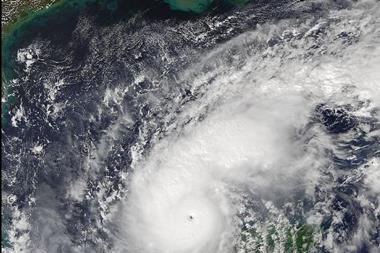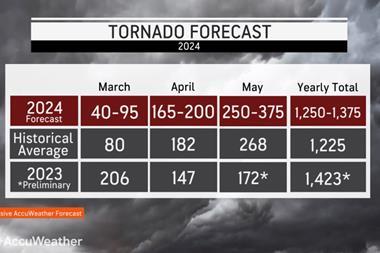Traditional risk management is a one-dimensional view connected to assessing insurable risks; and ERM can help peel back the onion layers to additional dimensions of risks. So how do we go beyond one-dimensional risk assessment? Carol Williams, enterprise risk management consultant and founder of ERM Insights, has this advise
In my popular article on traditional vs. enterprise risk management, one distinct difference is how traditional risk management assesses risk from only one-dimension point-of-view.
In most cases, the use of a one-dimensional view is strongly connected to insurable risks and determining the potential impact or loss from a particular event.
In the original article, I used the example of a wet floor sign in a store or restaurant lobby.
A traditional risk approach will, in most cases, solely be concerned with the impact if someone slips and falls on the premises. Once the property manager or safety officer understands the impact or severity (and the frequency of occurrence in some cases), he can then determine the right amount of liability coverage plus make any safety improvements.
This one-dimensional risk assessment brings up an important distinction – a risk versus an issue.
A “risk” represents the possibility of something while an “issue” is an event that has already occurred.
Whether it’s a property manager looking at liability coverage or an individual purchasing car insurance, each is evaluating, at least informally, the severity and frequency of something they know is going to happen.
They are in effect evaluating an “issue” and how it will impact them…
A “risk” on the other hand represents the possibility of something; it is therefore more of a proactive approach by default.
ERM peels back the onion layers to consider additional dimensions of possible events…
A multi-dimensional risk assessment undoubtedly will consider the potential impact of an event, but as we explain here, more information is needed to understand the truly important risks and how they connect to the strategic plan, organisational mission, or specific operation.
The most common dimension to consider beyond severity is probability or likelihood. For organisations new to ERM, assessing probability can be extremely helpful in determining the right risks to focus on.
A big impact risk event, for example, may also have a low chance of occurring, so would it be wise to focus scarce resources on something with a low chance of occurring?
Organisations who solely consider the impact of a risk run a high chance of wasting time, energy, and money on risks with a low chance of occurring.
Expanding the scope of a risk assessment to include likelihood adds tremendous value for the organisation in of itself.
Let me provide a first-hand example…
I recently helped a client put together a risk report for their board, who thought the report was one of the best they had seen. (It included probability and impact assessments for their top risks and explained why these were the top risks to the organisation.) When the client told me the board’s reaction, I was ecstatic that the board also told them they want to know more about the other high-impact risks, including ones with a low probability. In fact, they told management that the risks with a low impact – even those with a high probability – are not of interest to them.
By examining risks from multiple dimensions, the company’s executives and I were able to assure the Board the company was prioritising its efforts on the right things.
As your organisation’s ERM capabilities mature, there are additional factors you can consider to ensure you are focusing on the right risks, at the right time, and in the right amount. These can include:
- Velocity – how fast will we feel the effects of the risk?
- Pervasiveness – how widespread will the risk be?
- Persistence – how long will the effects of the risk last?
- Preparedness – how prepared are we to respond to the risk?
- Effectiveness – how effective are existing risk mitigation or “control” activities?
By evaluating probability and other factors like these, you are able to get different perspectives about risks and obtain additional information for prioritising.
But remember, not all factors will apply to every risk. Velocity, for example, may be irrelevant for short-term risks, so keep this in mind when examining multiple dimensions.
Taking baby steps when it comes to the risk assessment process is smart planning…
An organisation just starting to develop its ERM process will be wise to keep things simple in the beginning. As is the case with so many things, it can be easy to get overwhelmed when you try to conquer everything right out of the gate.
As assessment processes mature even more, your organisation can begin looking at multiple probabilities and severities.
Some industries like insurance, banking, and technology may have an inherent ability for sophisticated statistical modelling. But for others, getting to this point will take time. And that is okay…
Once you are ready to tackle more sophisticated methods, developing bell curve models like the following can even more valuable to the organisation because they allow you to consider more than just one probability or severity.
This can also be helpful for considering “black swan” events, or those with an extremely low probability but high, even devastating, impacts.
One example of a black swan event I am well familiar with is the 2004 hurricane season.
That year, 4 major hurricanes impacted our state (Florida) within 2 short months, with two of these storms on roughly the same path, which made it difficult for carriers to determine which event caused damages. (In fact, the map of the four hurricanes ranked as #10 on The Weather Channel’s list of the 15 Most Iconic Hurricane Images of All Times.)
The use of a risk assessment really comes down to value for the organisation…
Going beyond a one-dimensional risk assessment (i.e. severity) can enhance an organization’s long-term value. The thing to remember is to take your time to develop a process that works for your organisation before attempting to consider additional factors like velocity, persistence, and others.
For more articles from Carol, visit her website: www.ERMinsightsbyCarol.com




















No comments yet